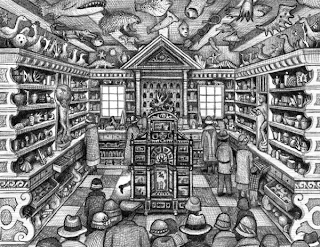Wonderstruck
By: Brian Selznick
Published by Scholastic Press, 2011
Awe-inspiring, Beautifully intertwined, Wondrous, Stunning Artwork, Determination
Awards:
- Schneider Family Book Award for Middle School Book (2012)
- Buckeye Children's Book Award for 3-5 (2012)
Summary: This novel tells the separate tales of a young boy named Ben and a young girl named Rose. Ben's story is told through words while Rose's story is told through pictures. Brian Selznick does a fantastic job bouncing back and forth between one story and the other, ultimately catching the reader off guard when these two stories, set more than fifty years apart, surprisingly intertwine.
Reading Level: Lexile Framework, 830L, Grade 4/5
Suggested Delivery: Independent Read
Key Vocabulary: (by page number) scavenged (10), drone (17,) ejecta (21), overcast (27), heavenward (56), silhouette (57), peculiar (68), indentation (86), curator (96), smoldering (157), disintegrated (308), undulating (344), non-circulating (381), portages (393), acquisition (409), carbon copy (450), revelation (483), incomprehensible (485), cavernous (551), radical (571)
4 Teaching Suggestions:
- Use this text to improve and further develop student's inferential comprehension. Rose's story is told only through pictures, so readers must infer what is happening through the drawings.
- Use this text to improve student's prediction skills. This book offers a lot of opportunities to where students can predict what will come next. It is important that teachers take advantage of those opportunities.
- One of the main settings in this text is the American Museum of Natural History. This text allows teachers to tie in the concept of museums and their purpose through a history lesson. Students can go in depth and research all different museums located around the world.
- The main characters in this story are deaf. Take the opportunity to discuss this disability in depth with students as well as other disabilities such as blindness.
Before Reading: Prior to reading this book, students will read the inside flap of the novel. After doing so they will make predictions about how they think these two world's will collide. They will also skim quickly through the text and discuss their thoughts on the whole "story-telling through pictures" concept.
 |
| A "Cabinet of Wonders" Exhibition |
During Reading: While reading the novel, students will keep a journal. Every time they come across the drawings depicting Rose's story, they will briefly write down what they believe is happening in her story. (Remember to write down page numbers!) This will help students when making predictions and it also allows them to reflect back on what is happening in Rose's story in case they forget or something is not making sense to them.
After Reading: Ben has his own "museum box" (or Cabinet of Wonders) where he keeps items that he believes represents him and his life so far. They are also particularly meaningful to him. Students will create their own version of a museum box, (ex. a shoe box), and place items in the box that are meaningful to them and that they think represent them.
Another option is to teach students fingerspelling and some simple sign language. There are a surplus of videos, websites and books that teach people how to sign. This activity will allow students to better understand the deaf community and one of the most common ways that they communicate.
Writing Activity: The very first illustration drawn in this novel is of two wolves. Explain the significance of wolves throughout the novel and how this "symbol" is carried out from the beginning of the novel until the end. How does Ben initially feel about the wolves? Does this change? Why and how? What is the connection between the wolves and Ben's life?
3 Electronic Resources:
- Scholastic: This link will bring you to a discussion guide created by Brian Selznick to help readers better understand and comprehend what is happening throughout the novel. This is a great tool to use either during or after reading. They are thoughtful, multiple part questions that will make the reader really think and provide in depth responses.
- American Museum of Natural History: This is a great website for students to explore. It lists all of the different exhibitions that is has, including the Wolf diorama. Students can learn more information on the Wolf diorama or research other exhibitions that interest them.
- Sounds of Silence: This link is a great source to check out before, during or after reading the novel. It explains what it is like to be deaf in a clear and simple manner. It also explains the causes of deafness and describes the different techniques the deaf community uses to communicate.
Selznick, B. (2011). Wonderstruck. New York: Scholastic Press

No comments:
Post a Comment